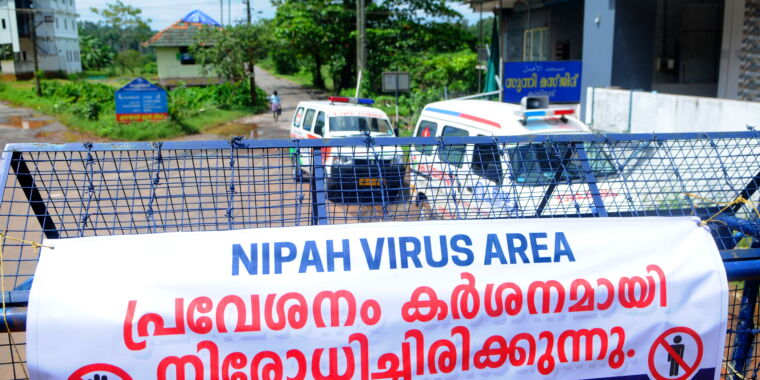
On the morning of September 11, critical care specialist Anoop Kumar was presented with an unusual situation. Four members of the same family had been admitted to his hospital—Aster MIMS in Kozhikode, Kerala—the previous day, all similarly sick. Would he take a look?
He gathered his team of doctors to investigate. Soon they were at the bedsides of a 9-year-old boy, his 4-year-old sister, their 24-year-old uncle, and a 10-month-old cousin. All had arrived at the hospital with fever, cough, and flu-like symptoms. The 9-year-old was in respiratory distress, struggling to breathe properly, and had needed to be put on a noninvasive ventilator, with air pumped through a mask to keep his lungs expanded.

Their symptoms were concerning and mysterious—none of the team could pinpoint what was wrong. But delving into their family history, Anoop and his colleagues soon uncovered a clue. The father of the two young siblings, 49-year-old Mohammed Ali, an agriculturalist, had died less than two weeks previously. And when the team at Aster MIMS got in touch with the hospital that had treated Ali, they found that he had been admitted with similar symptoms, pneumonia and fever.
Digging deeper, they learned from the other hospital that Ali had also had some neurological symptoms, which had seemingly been overlooked by his doctors—he’d had double vision, suffered seizures, and spoken with slurred speech. Despite this, Ali’s death had been attributed to “multi-organ failure,” a vague diagnosis with no indication of the cause. Alarm bells started ringing in Anoop’s head.
Ali’s case reminded Anoop of May 2018, when he’d diagnosed five patients with a combination of flu-like symptoms, respiratory distress, and neurological problems. Those patients had been suffering with a rare but deadly zoonotic virus called Nipah.
Believed to be spread to people from bats, Nipah has a fatality rate in humans of somewhere between 40 and 75 percent. In the 2018 outbreak in Kerala, India’s first ever, 18 people caught the virus. Seventeen died.
“You can contract it with direct contact with infected animals, such as bats or pigs, or from food or water contaminated with their body fluids,” says Thekkumkara Surendran Anish, associate professor for community medicine at the Government Medical College in Manjeri, Kerala, who leads the state’s Nipah surveillance team. “Close contact with an infected person and their bodily fluids can expose you to Nipah as well.” The virus has since emerged multiple times in Kerala.
Anoop and his team knew they had to act swiftly—there are no authorized treatments for Nipah, nor are there vaccines for protection. If the virus were to take hold or spread outside of the local area, the effects could be catastrophic. But first they needed confirmation.
The cluster of mysterious cases in these patients, their connection to Ali, his concerning neurological symptoms, his lack of a proper diagnosis—“We had strong reason to suspect Nipah again,” Anoop says. “Another red flag was the rapid decline of the patient,” Anoop says of Ali. Within a matter of days, he had fallen sick and died. And then there was one final alarm: “Ali lived close to the epicenter of Kerala’s 2018 Nipah outbreak.”
Fearing the worst, the team immediately isolated the patients and sent the family nose-and-throat swabs for testing. No sooner had they done this than another patient was admitted with similar symptoms. Forty-year-old Mangalatt Haris, who lived in Ayanchery, Kozhikode, arrived at Aster MIMS in critical condition. He died later that day. His nasal swab samples were sent to test for Nipah as well.
The results came back the following day—three of the patients had tested positive for the virus: Ali’s 9-year-old son, his 24-year-old uncle, and the seemingly unrelated Haris. The hospital where Ali had been treated had taken nasal swabs from him to rule out COVID and various other infections. These, too, were sent for testing, and turned out to be Nipah-positive, seemingly establishing Mohammed Ali as the first case in this outbreak.
But was he? Haris had no link with Ali’s family, nor did he live in the same neighborhood. He might have picked up the virus from someone unknown. Ali might not be the first case, just the earliest to have been spotted so far. Also on Anoop’s mind was the incubation period. The virus takes hold over 14 to 21 days, meaning weeks can pass between getting infected and showing signs of being ill. If others out there were involved in this outbreak, the virus could already have spread widely, unnoticed.
Code red
The gravity of the situation wasn’t lost on the state authorities. With these positive Nipah diagnoses confirmed, Kerala’s public health mechanism swung into overdrive. On September 13, health authorities divided the district into containment zones and instituted strict lockdown measures across them, just like they did for COVID. Schools, offices, and public transport were shut down, travel into and out of the zones was restricted, and only essential shops were allowed to stay open, and for limited hours. As a precaution, people had to use masks, practice social distancing, and use hand sanitizers. State health workers then set about the arduous task of contact tracing. They isolated anyone with a fever and traced 1,233 contacts of the cases—anyone who had come into contact with Mohammed Ali, his family, and the second patient Haris when they were likely to be infectious. One health worker tested positive.
Meanwhile, doctors were studying the family history of the second patient, Haris, to try to draw a link between the cases. Poring over his every move before he was admitted to Aster MIMS, they eventually made a breakthrough, thanks to some CCTV footage.
“We learned that Haris had accompanied his sick father-in-law, who was admitted in the same hospital [as Ali], and was in an emergency ward next to Ali’s,” says Anish. The two wards shared a health worker, whom authorities suspect may have spread the virus between the two.








